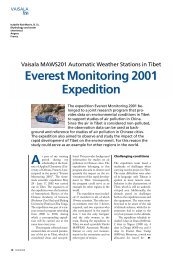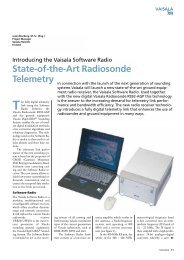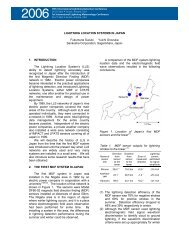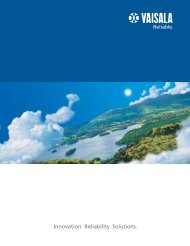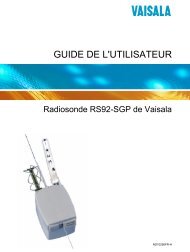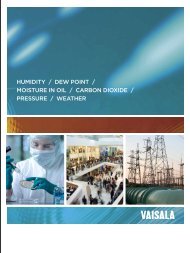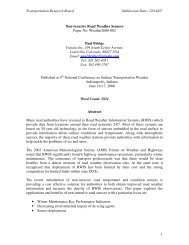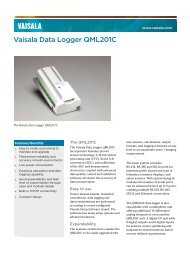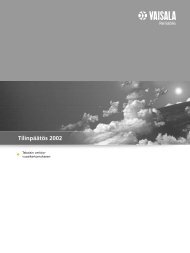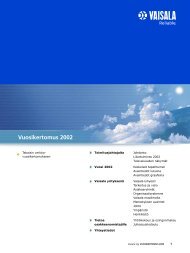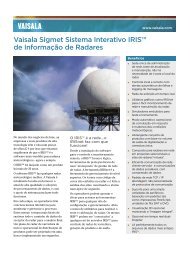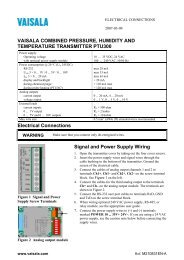Vaisala News 180 - Full Magazine
Vaisala News 180 - Full Magazine
Vaisala News 180 - Full Magazine
Create successful ePaper yourself
Turn your PDF publications into a flip-book with our unique Google optimized e-Paper software.
climate system. The area that we<br />
were looking at during the GFDex, the<br />
Irminger Sea between Greenland and<br />
Iceland and the Greenland Sea north<br />
of Iceland, is thought to be a key part<br />
of the thermohaline circulation; the<br />
large scale overturning ocean circulation<br />
that is partly responsible for the<br />
temperate climate of Europe. This<br />
circulation is driven by temperature<br />
and salinity making it almost<br />
entirely horizontal. The vertical<br />
overturning happens only in a few<br />
places, restricted by a cyclonic gyre<br />
and cold, strong winds sucking heat<br />
and moisture out of the ocean. When<br />
these conditions are fulfilled, openocean<br />
convection can happen and<br />
dense water sinks down to the ocean<br />
bed. Such open-ocean convection<br />
has been found in the Labrador Sea,<br />
between Greenland and Canada, and<br />
in the Greenland Sea. Recently, the<br />
Irminger Sea has also been recognised<br />
as a region where these conditions<br />
may be met, with the strong low level<br />
wind jets formed due to the impact of<br />
Greenland on the atmospheric flow<br />
playing an important role.<br />
Among the aims of the GFDex<br />
field campaign was to measure the<br />
atmosphere in these strong winds as<br />
well as sample the air-sea fluxes that<br />
are important for the climate system.<br />
Intensive field campaign<br />
preparations<br />
Going on a field campaign like this<br />
one is not done without preparations.<br />
For example I was a part of<br />
a group going to Iceland, where we<br />
had our field base during the flying<br />
campaign, 6 months prior to the<br />
campaign. Among the tasks was to<br />
find a suitable hotel with a conference<br />
room we could take over during<br />
the field campaign. We spoke to<br />
the civic aviation administration,<br />
introducing our plans to them and<br />
discussing possible problems and<br />
solutions. At the airport we met up<br />
with the ground handling service<br />
companies and inspected aircraft<br />
hangars we might possible use<br />
during the field campaign.<br />
During the following months<br />
the planning intensified. The UK<br />
Met Office, the European Centre for<br />
Medium-Range Weather Forecasts<br />
and the Icelandic Met Office tailored<br />
weather charts for us, we planned<br />
the day-to-day schedule and tried<br />
to prepare ourselves as well as<br />
possible. We also discussed which<br />
instruments we needed onboard the<br />
aircraft. As we were flying in an area<br />
with few airports - and a lot of open<br />
water - we needed the aircraft to be<br />
as light as possible so we had as long<br />
flight range as possible.<br />
Long days on and<br />
off the ground<br />
The group met in Iceland on 19<br />
February 2007. It consisted of the<br />
aircraft crew and atmospheric scientists<br />
from the UK, Iceland, Norway,<br />
Canada and the US. Each day the<br />
weather forecasts for the next few<br />
days were studied and discussed.<br />
New forecasts arrived every 6 hours<br />
but those most important for the<br />
planning were available early in<br />
the morning. If it was decided to fly<br />
the day after the flight mission was<br />
planned in details with the help of<br />
one of the pilots, the objectives,<br />
the flight track and what kind of<br />
observations were needed. The days<br />
on the ground were long and filled<br />
with weather discussions and flight<br />
planning, but the days when we were<br />
flying were even longer.<br />
We usually took off at 10:30LT<br />
with one flight taking off as early as<br />
08:00LT. This may sound like a late<br />
start but the preparations for each<br />
flight took about 3.5 hours. This<br />
meant that at 7 o’clock the engineers<br />
started preparing the aircraft. At<br />
a similar time the scientists flying<br />
that day had a final look at the latest<br />
forecasts and satellite pictures and<br />
prepared for a pre-flight brief. The<br />
flights lasted for 4-6 hours and every<br />
flight mission ended with a debrief in<br />
the conference room around five in<br />
the afternoon. There would then be an<br />
update from the ground crew about<br />
the decisions made regarding the next<br />
day and the eventual preparations.<br />
The discussions and planning could<br />
then last into the evening.<br />
Good atmospheric<br />
data gained<br />
During the three weeks in Iceland we<br />
flew twelve times sampling a mixture<br />
of high impact weather events, an<br />
easterly tip jet at the southern tip of<br />
Greenland, barrier flow parallel to<br />
the coast of Greenland, lee cyclones<br />
and a polar low north of Iceland.<br />
When mapping out the low level jet<br />
we usually flew at 18-20 thousand<br />
feet height (5-6 km). The atmosphere<br />
at the flight level was measured by<br />
the instrumented aircraft, e.g. wind<br />
speed and direction, temperature,<br />
humidity and ozone concentration.<br />
At regular intervals dropsondes were<br />
launched. A dropsonde is the falling<br />
equivalent of a radiosonde making<br />
a vertical profile of the atmosphere.<br />
However, instead of being attached<br />
to a balloon it has a parachute and<br />
is dropped from an aircraft. The<br />
measurements are transmitted back<br />
to the aircraft for onward satellite<br />
transmission into the Global<br />
Telecommunication System (GTS).<br />
Measuring the impact of these strong<br />
winds on the ocean below meant<br />
flying at about 100 feet (~30 m) above<br />
the ocean to make measurements<br />
of fluxes of momentum, heat and<br />
moisture from the ocean to the atmosphere.<br />
At such low levels in strong<br />
winds you were in for a bumpy ride!<br />
The field campaign was<br />
successful and we left Iceland with<br />
loads of atmospheric data. Since<br />
then we have been working hard<br />
analysing the data and looking at the<br />
cases in details. The field campaign<br />
was hard work, early mornings, late<br />
evening and long days but it was also<br />
a fantastic experience working in a<br />
group with the main goal of every day<br />
making the best possible measurements<br />
of the extreme weather.<br />
Further information:<br />
www.vaisala.com/weather/<br />
products/soundingequipment<br />
<strong>180</strong>/2009 17




